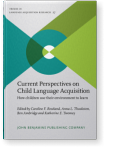The emergence of gesture during prelinguistic interaction
The emergence of intentional prelinguistic communication demonstrates in the most basic terms, the essence of language and the dynamic nature of communicative development. The chapter provides an overview of prelinguistic development from a dynamic perspective, beginning with a discussion of joint attention skills and patterns of triadic interaction, followed by a description of prelinguistic gesture development. The chapter presents a dynamic, interactive account of development in which infant gestures become social over time through interaction with more experienced co-participants. The chapter concludes by considering prelinguistic gestures cross-culturally and the challenges associated with studying this rich and interactive aspect of development.
Article outline
- Preface
- Introduction
- The development of triadic attention and joint action
- The development of prelinguistic communicative gestures
- Theoretical perspectives on the emergence of declarative gestures
- Prelinguistic gesture development across cultures
- Summing up
-
References
